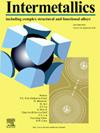The influence of Mn and Cr elements on the isothermal oxidation behavior of γ-TiAl alloys
IF 4.8
2区 材料科学
Q2 CHEMISTRY, PHYSICAL
引用次数: 0
Abstract
This study systematically analyzed the thermal exposure behavior of two gamma titanium aluminide alloys (Ti-48Al-2Mn-2Nb and Ti-48Al-2Cr-2Nb) to investigate the effects of Mn and Cr elements on the oxidation resistance of the alloys at different temperatures of 750 °C, 850 °C, and 950 °C. At 750 °C and short thermal exposure times, Mn increases the α2 transformation temperature and reduces the α2 phase content, thereby hindering the diffusion of oxidation atmosphere and enhancing the oxidation resistance of the alloy. At increasing temperature, Mn tends to form oxidation products, disrupting the continuity of the oxidation layer and reducing the bonding strength, which has a detrimental effect on the oxidation resistance of the alloy. At low Cr contents, as the thermal exposure time increases, Cr exists in the form of Cr3+, increasing the concentration of oxygen vacancies and promoting the growth of TiO2, thereby weakening the oxidation resistance of the alloy. At 750 °C, Ti-48Al-2Mn-2Nb exhibits better oxidation resistance; at 850 °C, the two alloys have similar oxidation resistance; and at 950 °C, the oxidation scale thickness increases dramatically, with Ti-48Al-2Mn-2Nb experiencing severe oxidation layer shedding, whereas Ti-48Al-2Cr-2Nb shows relatively good oxidation resistance.
Mn和Cr元素对γ-TiAl合金等温氧化行为的影响
本研究系统分析了两种γ钛铝合金(Ti-48Al-2Mn-2Nb和Ti-48Al-2Cr-2Nb)在750℃、850℃和950℃不同温度下的热暴露行为,探讨了Mn和Cr元素对合金抗氧化性能的影响。在750℃和较短的热暴露时间下,Mn提高了α2相变温度,降低了α2相含量,从而阻碍了氧化气氛的扩散,增强了合金的抗氧化性。随着温度的升高,Mn容易形成氧化产物,破坏氧化层的连续性,降低结合强度,对合金的抗氧化性能产生不利影响。在Cr含量较低时,随着热暴露时间的增加,Cr以Cr3+的形式存在,增加了氧空位的浓度,促进了TiO2的生长,从而削弱了合金的抗氧化性。在750℃时,Ti-48Al-2Mn-2Nb表现出较好的抗氧化性;在850℃时,两种合金具有相似的抗氧化性能;950℃时,氧化层厚度急剧增加,Ti-48Al-2Mn-2Nb氧化层脱落严重,而Ti-48Al-2Cr-2Nb具有较好的抗氧化性。
本文章由计算机程序翻译,如有差异,请以英文原文为准。
求助全文
约1分钟内获得全文
求助全文
来源期刊

Intermetallics
工程技术-材料科学:综合
CiteScore
7.80
自引率
9.10%
发文量
291
审稿时长
37 days
期刊介绍:
This journal is a platform for publishing innovative research and overviews for advancing our understanding of the structure, property, and functionality of complex metallic alloys, including intermetallics, metallic glasses, and high entropy alloys.
The journal reports the science and engineering of metallic materials in the following aspects:
Theories and experiments which address the relationship between property and structure in all length scales.
Physical modeling and numerical simulations which provide a comprehensive understanding of experimental observations.
Stimulated methodologies to characterize the structure and chemistry of materials that correlate the properties.
Technological applications resulting from the understanding of property-structure relationship in materials.
Novel and cutting-edge results warranting rapid communication.
The journal also publishes special issues on selected topics and overviews by invitation only.
 求助内容:
求助内容: 应助结果提醒方式:
应助结果提醒方式:


